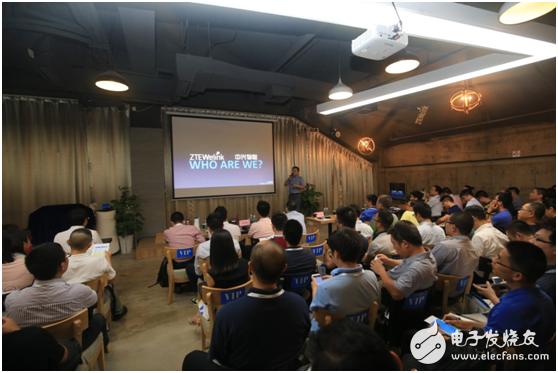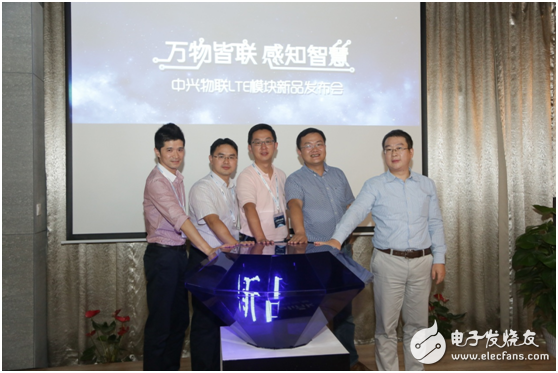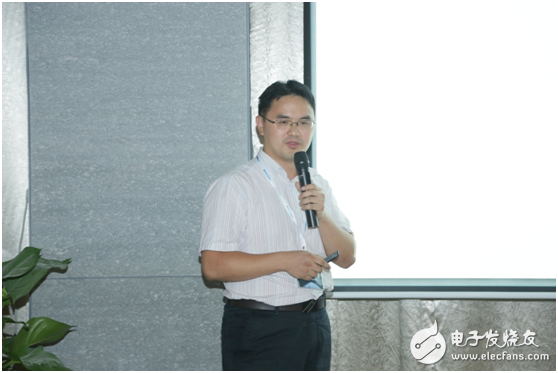The vigorous development of the Internet of Things and the gradual improvement of the 4G mobile communication network have made the long-distance M2M application an important part of the Internet of Things industry and strongly promoted the all-round extension of the Internet of Things application. As a wholly-owned subsidiary of ZTE, ZTE has been deeply cultivating module products for thirteen years, and Houjifang can make thin hair. On August 5th, the “All things are organized by ZTE and sponsored by Shenzhen Siruida Media. Perceived Wisdom - 2015 ZTE's full range of LTE module new product launch conference was held in Shenzhen Nanshan District Software Industry Base. The new series of LTE modules was unveiled in a high-profile manner, setting a leading position in the industry with a strong posture. The new series of LTE modules have been unveiled in a high-profile manner, setting a leading position in the industry with a strong posture. In addition, partners from operators, chip platforms and vertical industries have attended the event, and a technical feast in the field of IoT has been a complete success!

Figure 1: The press conference is full of guests
At the meeting, Mr. Wang Peng, deputy general manager of ZTE Corporation, made a detailed analysis of the development process and current stage of 4G communication, as well as the internal and external factors and core technical strength of the product launch, followed by the general manager of Zhongxing IOT, Gu Yongcheng and the speakers. Together, the opening ceremony of the new LTE module was launched, which pushed the meeting to the climax.

Figure 2: Wang Peng, Deputy General Manager of Zhongxing IOT
The new series is launched: standard LTE module vLink, extended LTE+WiFi module vFi, intelligent LTE module vFree
Although the company was established only for more than two years, ZTE has a profound industry background. Born in a 30-year-old communications leader such as ZTE ZTE, the success of ZTE Welink is not without trace. Wang Peng, deputy general manager of ZTE, attributed this to a seed with good genes in fertile soil. When the outside sun and rain come, it will naturally sprout, grow and grow. As early as 2003, ZTE began to focus on the IoT field. From the concept of the IoT to the explosive growth of the entire industry in the last year, the connected devices of the terminal and the big data generated by the connection all represent huge business opportunities and represent a The market is mature. With the maturity of 4G technology, its proportion in M2M connection will also become larger and larger, especially LTE-Advanced, Cat.1/MTC will gradually become the mainstream.
ZTE's products cover LTE system equipment, terminal products, LTE modules, and LTE chip platforms. It is the first company in China to develop LTE modules. Its LTE module has been commercialized in 2010. In 2014, ZTE Corporation released the industry's thinnest TD-LTE module ME3860 module based on ZTE's own chip platform. This is the year of the ZTE LTE module explosion. Then more and more of its partners, involving various industries, with such a deep precipitation and accumulation, today has produced a new fruit - the full range of LTE modules vLink, vFi, vFree.
v homophonic We, meaning ZTEWelink. The three major series have the main features.
vLink Series: The LINK, the most core function in the interconnection, is a traditional industrial-grade module series, including the ME3620 and ME3760V3. The ME3620 is an industrial-grade module based on the Qualcomm platform that supports five-mode fourteen-frequency and rich interfaces. It also belongs to the same series, including WCDMA modules MW3620, MW3650, and EV-DO module MC8635, which are the same size and fully compatible with all hardware interfaces. The ME3760V3 is based on ZTE's independent R&D platform and supports four-mode ten-frequency, mainly for the Chinese mobile market, and is an upgraded version of the 3760 series.
vFi series: MV3500 module integrates WiFi inside. For the rise of the Internet of Vehicles, the vFi series modules can help customers develop quickly. It changed the MCU+LTE module+WiFi chip architecture of the original design, directly embedded the WiFi chip into the LTE module, reduced the requirements for the MCU processing capability, simplified the customer debugging work, and accelerated the product development cycle.
vFree series: MV3880 module gives users a high degree of freedom. It is a module with intelligent operating system. It is the industry's first in-vehicle LTE module, which can help car and smart rearview mirror manufacturers to quickly launch smart LTE products.

Figure 3: Gu Yongcheng, General Manager of ZTE Corporation, and Wang Peng, Deputy General Manager, together with the speakers, unveiled the launch of the new LTE module.
Compared with other similar products, Wang Peng said that for the IoT industry, the performance and safety of the products are of vital importance, and ZTE, as a brand, provides customers with high performance and high reliability of industrial products, especially They have many unique advantages, especially in terms of communication metrics, original WeFoTa technology, and never crash. At the same time, ZTE is not a pure module supplier, but is committed to building a cooperative and win-win ecosystem, working with operators, chip platforms, and vertical industries to create a better future for the future.
For the future development of LTE, Wang Peng said that LTE will move toward two different types of application scenarios, on the one hand, high speed, mobile, suitable for large data IoT applications, such as Cat.11/12, on the other hand, low. Speed, low cost, low latency, low power consumption, wide coverage, such as Cat.0/1. Today is just the beginning, and soon ZTE will have more surprise products to launch.
Operators, chip platforms, vertical industries, talk about the future of Internet of Things LTE
At the press conference, the close partners from ZTE's industrial ecosystem also carried out in-depth and innovative research on the status quo and trends of the Internet of Things, the development of mobile communication technologies, and related application fields, starting from the Internet of Things and their own industry roles. Research and elaboration.
Xiao Qing, senior technical director of China Mobile Internet of Things, focused on several trends in the development trend of the Internet of Things, including: by 2020, the number of M2M devices connected based on cellular networks is expected to be close to 600 million; the Internet of Things industry chain is showing downstream, profits And the higher the development potential; the car networking and smart wearable device industry has initially formed a scale. China Mobile Internet of Things has launched four business directions in this direction, including intelligent pipelines, open platforms, device devices, and IoT application integration.

Figure 4: Xiao Qing, Senior Technical Director, China Mobile Internet of Things
Focusing on the industrial chain, from the perspective of the upstream platform, ZTE's IoT module products are mainly based on the Qualcomm platform and the chip platform independently developed by ZTE. During the conference, Guo Peng, Senior Product Marketing Manager of Qualcomm China, gave a wonderful view on "Internet of Everything in the Post-LTE Times" and introduced the future technology trends of LTE technology in the field of IoT applications, including LTE Advanced and LTE Cat. Release 13 and later LTE-M. Ni Haifeng, vice president of ZTE Microelectronics Research Institute, focused on ZTE's latest developments in LTE chips. The company's views on the Internet of Things, especially the Internet of Things based on cellular communication systems, and chips in the long-distance applications of the Internet of Things. Product layout. Later, Zhao Shanren, president of the Xiamen Internet of Things Association, talked about the hot research content of the Internet of Things, the main problems faced by the Internet of Things and the needs of mobile communications.
From the downstream point of view, in the next three years, the tentacles of IoT applications will be fully extended. Vehicle, smart grid, mobile payment, security monitoring, remote monitoring and control will become the five areas with large shipments of long-distance M2M modules. . In this regard, ZTE's application partners on behalf of Shanghai Botai project director Yuan Shuning introduced the related technologies of car networking and intelligent transportation and car networking from inside to outside, Shanghai Botai Banyan is also the first in China. Introduced the pre-installed TSP company of the intelligent terminal concept car; Gao Gangqiang, the director of computer research and development of Fujian Shida, talked about the status of domestic electronic payment from the perspective of POS machine, and the change of payment under the mobile internet in 4G era.
Insulation Tubes,Pvc Pipe Insulation,Insulated Pex Pipe,Rubber Insulation Tube
Shenzhen Huiyunhai Tech.Co., Ltd. , https://www.cablesleevefactory.com
